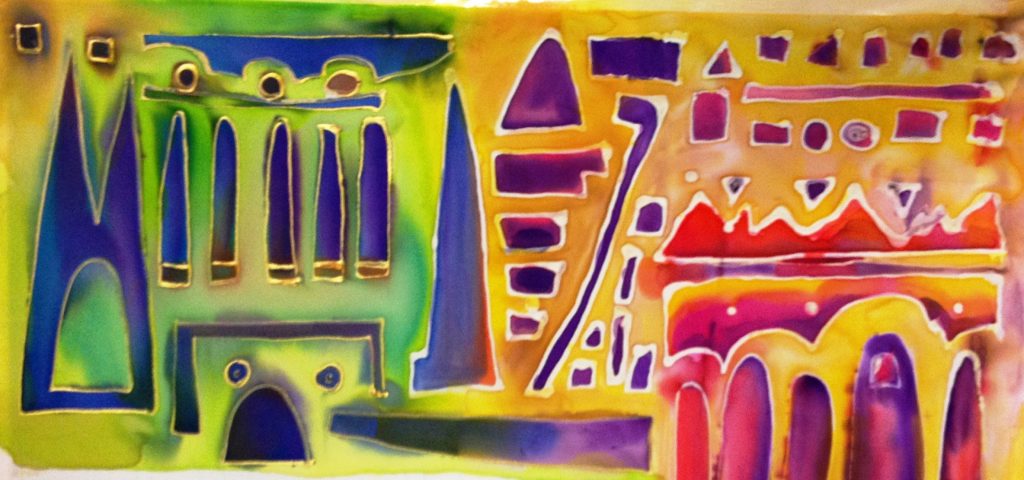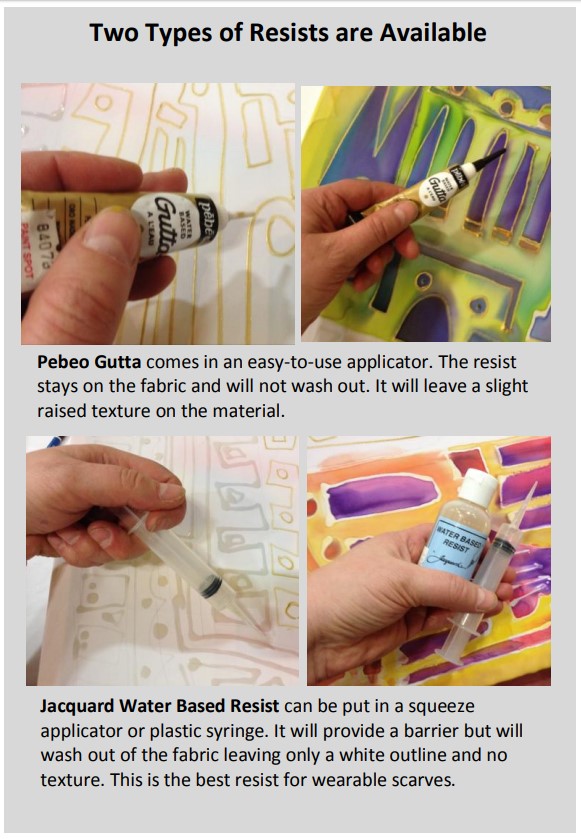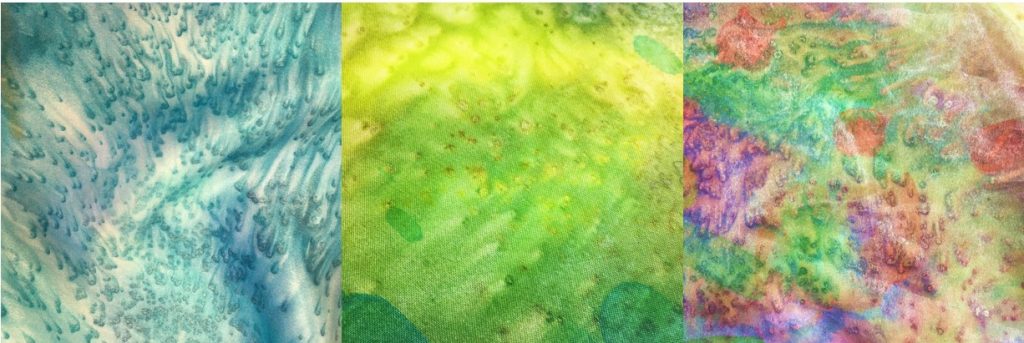Follow along to learn three techniques to approach creative and beautiful fabric painting projects.
3 easy techniques
Jacquard Dye Na Flow is an excellent textile paint and will create professional results in your custom-painted art and wearable items. The paint comes ready to use and can be thinned with water to create lighter or pastel colours. Or use it straight from the jar for intense dark colour. When dry the colour is invisible to the touch yet the colours remain bright, bold, and non-fading – even in bright sunlight because the pigment is lightfast and uv-stable.
Stunning results can be created by working loosely and abstractly with the colour. Basically, if you have ever spilled food and stained your clothes then you are already an accomplished fabric painter. Here are three easy techniques to help you control colour and create special effects.
Basic fabric painting technique
Wet Paint on dry fabric or wet paint on wet fabric
- Simply apply Dye Na Flow to prewashed fabric with a brush, squirt bottle, sponge, or airbrush.
- Let dry.
- Iron fabric for 3 minutes on dry setting appropriate or fabric.
- Wash in cool water with Synthrapol and rinse.
Fabric Painting is a great school project for Mother’s Day scarves or classroom banners. It is also a consistent collectible at artisan markets.
Materials
- Jacquard Dye-Na-Flow fabric paint in your choice of colours – available i assorted sets and class packs. Single colours are available in 2 oz and 8 oz sizes.
- Any lightweight fabric: Dye-Na-Flow works on both natural and synthetic fibers.
- Pencil OR Auto-fade Pen
- Soft synthetic paint brush
- Jacquard Water-based Resist, clear OR Jacquard Metallic Permanent Resist OR PÉBÉO Outliner
- Squeezable applicator for resist and metal tips (or a plastic syringe)
- Iron for heat setting fabric paint
- Synthrapol for washing fabric (optional)
Preparation: Prewash fabric to remove dirt, starch, and sizing.
Resist technique (Serti)
In the resist technique, lines are drawn on the fabric with Jacquard Water-based Resist or Pebeo Gutta and the Dye-Na-Flow is applied within these lines. The fabric paint will flow and spread on the fabric until it reaches the resist lines. The resist acts as a boundary between colours much like lead in a stained glass window. These islands of colour can be blended, highlighted, or accented with other colours. Download this project Idea.


Instructions
- Draw your design with an auto-fade pen onto the fabric OR place an easy-to-see (e.g., marker) drawing behind your fabric and trace it with a pencil.
- Pour the Water-based resist or Gutta into a plastic applicator bottle with a metal tip.
- Hold the resist bottle like a pencil. Gently squeeze the bottle until the resist begins to flow. It is a good idea to practice on a separate piece of fabric until you get the feeling of drawing smooth, flowing, continuous lines.
- Begin drawing your pattern. Move steadily, but not so quickly that you leave gaps in your lines. Paints will bleed through gaps in the resist line – make sure all lines are connected.
- Once you have completed the design, carefully examine the lines, making sure the resist has penetrated through to the back. Fill in any gaps. Let the resist dry completely. Use a hair dryer to speed drying time.
- Mix and apply the paint. Although Jacquard Dye-Na-Flow is available in 30 colours, you can also mix your colours. Using the colours full strength will yield the brightest shades. Mix the dyes with up to 25% water for less vibrant colours or for watercolour washes.
- Dip your brush gently into a colour. Touch the brush to the fabric about 1/2” from the resist line. The dye will migrate the rest of the way. Paint all areas inside the resist lines. For large areas, work quickly painting the colour from corner to corner. Always work wet to wet. Never go over a dry area.
- After you have finished your piece, let dry completely. Heat set according to instructions.


Salt technique
There’s more than one way to achieve creative results when fabric painting. You’ll achieve a beautiful starburst effect by sprinkling salt over the fabric while the Dye-Na-Flow is wet.
- Paint, squirt, or sponge the Dye-Na-Flow on the fabric in an all-over pattern.
- Sprinkle the salt onto the fabric. Immediately apply the salt to the very wet fabric. The salt crystals will begin to soak up the dye as it dries.
- Let the salt sit on the fabric until the paints are dry.
- Brush the salt off the fabric.

_________________________
Kim Fjordbotten (August 2020) As the owner of The Paint Spot, Kim Fjordbotten is passionate about helping artists use materials and make art. She is available as a speaker and educator for teachers and art associations. The Paint Spot offers exhibitions, workshops, and beautiful art materials to inspire your creativity.
Notice you are not bombarded with advertising while sourcing this information. Please help us by purchasing your art supplies from The Paint Spot. We really appreciate your business and it means we can keep making educational posts for free. Thank you.

